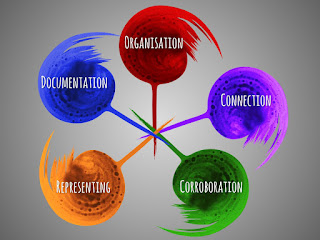I thought I would expand on all five of these steps in this post. They are (Schutt, 2011, p. 325):
- "Documentation of the data and the process of data collection": this is where we have gathered all our field notes together. We have reflected, we have organised our field notes; we have digitised everything. We have a research diary which we have noted our impressions in, and we have digitised this as well. We may start to see concepts, and should be making notes as we document - "margin notes', effectively - that may form the basis of our coding. We start preliminary categorisation of responses.
- "Organization/categorization of the data into concepts": this is where we have started to see connections between our various groups of data. We can see the tenuous connections, ideas are beginning to form. We may need to discuss our ideas with others, to read more widely, to look for whether this has happened elsewhere to "resolve points of confusion". We need to interact with our data repeatedly, over time. Schutt suggests using a checklist matrix to interrogate our data.
- "Connection of the data to show how one concept may influence another". We look for connections; we look for hierarchy; we look for 'upstream' and 'downstream'; we look for difference; and we look for sameness. We start to see the outlines of influence, of relationships, of connectedness. An example which Schutt uses is from Becker (1958):
"When we first heard medical students apply the term 'crock' to patients, we made an effort to learn precisely what they meant by it. We found, through interviewing students about cases both they and the observer had seen, that the term referred in a derogatory way to patients with many subjective symptoms but no discernible physical pathology. Subsequent observations indicated that this usage was a regular feature of student behavior and thus that we should attempt to incorporate this fact into our model of student-patient behavior. The derogatory character of the term suggested in particular that we investigate the reasons students disliked these patients. We found that this dislike was related to what we discovered to be the students’ perspective on medical school: the view that they were in school to get experience in recognizing and treating those common diseases most likely to be encountered in general practice. 'Crocks,' presumably having no disease, could furnish no such experience" (Schutt, 2011, p. 328) - "Corroboration/legitimization, by evaluating alternative explanations, disconfirming evidence, and searching for negative cases". We start to see what is really there, instead of what we expect to see. This is the hardest part for all of us. We can often be blind to what we are seeing. We need to be sure that what we are seeing is authentic.
- "Representing the account (reporting the findings)". Writing. Rewriting. Polishing. Seeking clarity in the account.
Sam
- Reference: Schutt, R. K. (2012). Investigating the Social World: The Process and Practice of Research (7th ed.). Pine Forge Press.


No comments :
Post a Comment
Thanks for your feedback. The elves will post it shortly.